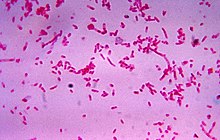
Back مغزلية (بكتيريا) Arabic مغزليه ARZ Fusobacteri Catalan Fusobakterien German Batērfûś EML Fusobacterium Spanish Fusobacterium Basque Fusobacterium French Fusobacterium Irish Fusobacterium Galician
| Fusobacterium | |
|---|---|

| |
| Fusobacterium novum in liquid culture | |
| Scientific classification | |
| Domain: | Bacteria |
| Phylum: | Fusobacteriota |
| Class: | Fusobacteriia |
| Order: | Fusobacteriales |
| Family: | Fusobacteriaceae |
| Genus: | Fusobacterium Knorr 1923 |
| Type species | |
| Fusobacterium nucleatum[1] Knorr 1923
| |
| Species | |
|
See text | |
| Synonyms | |
| |
Fusobacterium is a genus of obligate anaerobic, Gram-negative,[2] non-sporeforming bacteria[3] belonging to Gracilicutes. Individual cells are slender, rod-shaped bacilli with pointed ends.[4][5] Fusobacterium was discovered in 1900 by Courmont and Cade and is common in the flora of humans.[6][7]
Strains of Fusobacterium can cause several human diseases and infections, including periodontal diseases, Lemierre's syndrome,[8] oral, head, and neck infections, as well as colorectal cancer and topical skin ulcers.[9]
It has been tied[clarification needed] to HIV infection and suboptimal immune recovery.[10] Detection of Fusobacterium is typically through surgical retrieval of tissue, fecal tests, or blood tests in patients showing symptoms.[2] Early detection is preferred and helps to prevent further disease progression.[6]
Although older sources state that Fusobacterium is part of the normal flora of the human oropharynx, the current consensus is that Fusobacterium should always be treated as a pathogen.[11] There are thirteen described Fusobacterium strains; the predominant one affecting humans is F. nucleatum,[12] followed by F. necrophorum, which also affects animals, mainly cattle.[13]
- ^ Parte, A.C. "Fusobacterium". LPSN.
- ^ a b Arane, Karen; Goldman, Ran (October 2016). "Fusobacterium infections in children". Canadian Family Physician. 62 (10): 813–814. PMC 5063768. PMID 27737977.
- ^ Broadley, Marissa; Schweon, Steven J. (May 2017). "Get the facts about Fusobacterium". Nursing2023. 47 (5): 64–65. doi:10.1097/01.NURSE.0000515524.23032.d5. ISSN 0360-4039. PMID 28445341. S2CID 41693034.
- ^ Madigan M; Martinko J, eds. (2005). Brock Biology of Microorganisms (11th ed.). Prentice Hall. ISBN 978-0-13-144329-7.
- ^ Taber's Cyclopedic Medical Dictionary, 22nd Edition, ISBN 9780803629790, (2009)n p.983
- ^ a b Cheung, Winson (September 2007). "Fusobacterium". Canadian Family Physician. 53 (9): 1451–1453. PMC 2234623. PMID 17872873.
- ^ Garcia-Carretero, Rafael; Lopez-Lomba, Marta; Carrasco-Fernandez, Blanca; Duran-Valle, Maria Teresa (October 2017). "Clinical Features and Outcomes of Fusobacterium Species Infections in a Ten-Year Follow-up". Journal of Critical Care Medicine (Universitatea de Medicina Si Farmacie Din Targu-Mures). 3 (4): 141–147. doi:10.1515/jccm-2017-0029. PMC 5769905. PMID 29967887.
- ^ Ehlers Klug, Tejs; Rusan, Maria; Fuursted, Kurt; Ovesen, Therese (15 November 2009). "Fusobacterium necrophorum: Most Prevalent Pathogen in Peritonsillar Abscess in Denmark". Clinical Infectious Diseases. 49 (10): 1467–1472. doi:10.1086/644616. PMID 19842975.
- ^ Shang, Fu-Mei; Liu, Hong-Li (15 March 2018). "Fusobacterium nucleatum and colorectal cancer: A review". World Journal of Gastrointestinal Oncology. 10 (3): 71–81. doi:10.4251/wjgo.v10.i3.71. PMC 5852398. PMID 29564037.
- ^ Lee, Soo Ching; Chua, Ling Ling; Yap, Siew Hwei; Khang, Tsung Fei; Leng, Chan Yoon; Raja Azwa, Raja Iskandar; Lewin, Sharon R.; Kamarulzaman, Adeeba; Woo, Yin Ling; Lim, Yvonne Ai Lian; Loke, P’ng; Rajasuriar, Reena (2018-09-24). "Enrichment of gut-derived Fusobacterium is associated with suboptimal immune recovery in HIV-infected individuals". Scientific Reports. 8 (1): 14277. Bibcode:2018NatSR...814277L. doi:10.1038/s41598-018-32585-x. ISSN 2045-2322. PMC 6155144. PMID 30250162.
- ^ Aliyu SH, Marriott RK, Curran MD, et al. (October 2004). "Real-time PCR investigation into the importance of Fusobacterium necrophorum as a cause of acute pharyngitis in general practice". J Med Microbiol. 53 (Pt 10): 1029–35. doi:10.1099/jmm.0.45648-0. PMID 15358827.
- ^ Citron, Diane (September 2002). "Update on the Taxonomy and Clinical Aspects of the Genus Fusobacterium". Clinical Infectious Diseases. 35 (s1): S22–S27. doi:10.1086/341916. PMID 12173104. Retrieved 5 May 2023.
- ^ Tadepalli, S.; Narayanan, S. K.; Stewart, G. C.; Chengappa, M. M.; Nagaraja, T. G. (2009-02-01). "Fusobacterium necrophorum: A ruminal bacterium that invades liver to cause abscesses in cattle". Anaerobe. Foodborne and Gastrointestinal Pathogen Ecology and Control in the Intestinal Tract. 15 (1): 36–43. doi:10.1016/j.anaerobe.2008.05.005. ISSN 1075-9964. PMID 18595747.
© MMXXIII Rich X Search. We shall prevail. All rights reserved. Rich X Search